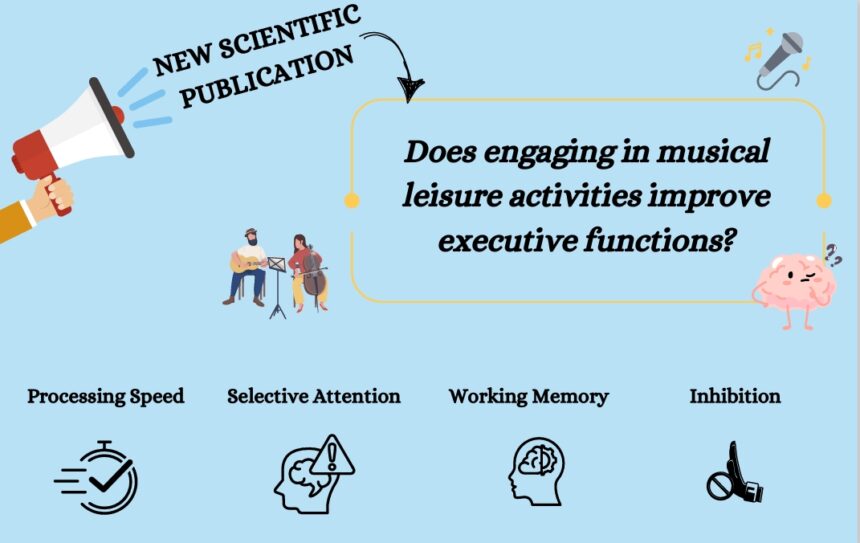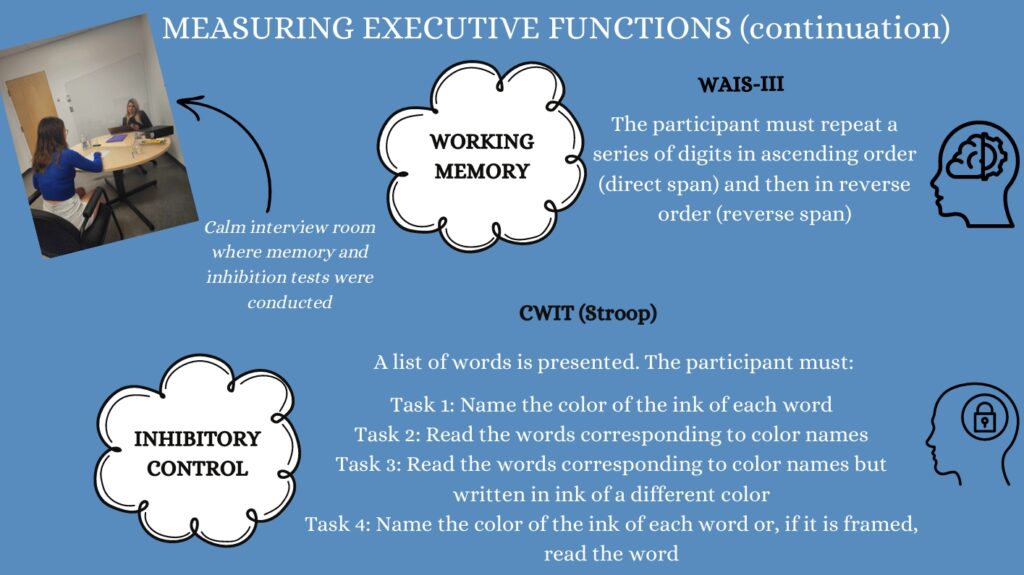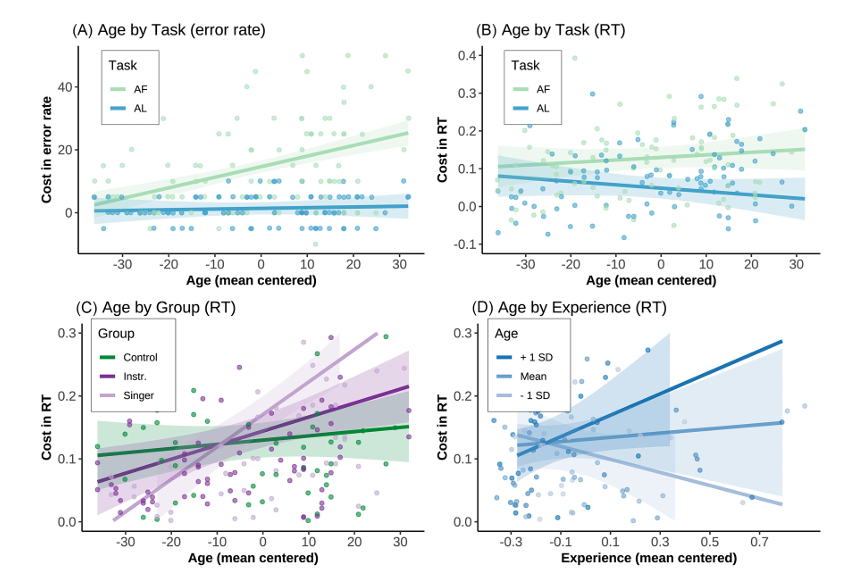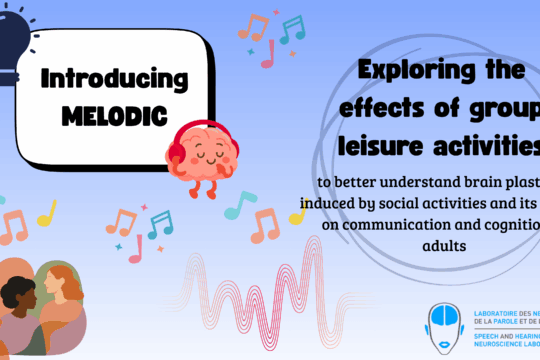New Scientific Article on the Links Between Musical Activity Practice and Executive Functions

We are pleased to present the results of our recently published study on the benefits of engaging in musical activities on cognition, conducted as part of our ambitious research project named PICCOLO (Practice of an Instrument or Singing on COgnition, Language, and Brain Organization).
To function in our everyday lives and carry out both complex and simple daily tasks, we rely on a set of cognitive processes known as executive functions. These functions enable individuals to coordinate, organize, and adjust their actions and thoughts to achieve a goal, such as planning a route, solving an unexpected problem, or inhibiting an impulsive response.
Unfortunately, these functions decline with aging. However, several studies have highlighted a positive association between certain cognitively demanding leisure activities, such as musical practice, and executive functions. This could represent a potential avenue for maintaining, and possibly even rehabilitating, executive functions in older adults. Nevertheless, the relationship between musical activities and executive functions remains poorly understood. Several questions remain unanswered, including:
- Are different types of musical activities associated with distinct executive benefits?
- Does the extent of musical experience influence the magnitude of executive benefits?
The study we present here, published in 2024 in the scientific journal Annals of the New York Academy of Sciences, explores these questions. It is part of our PICCOLO research project (to learn more about PICCOLO, click here). The objective of the study was to compare four executive functions between amateur singers, instrumentalists, and individuals engaged in non-musical cognitive-motor activities, according to their age. Additionally, we aimed to determine whether the type of musical activity and the extent of musical experience led to significant differences in executive functions. The study was conducted by a multidisciplinary team under the direction of Pascale Tremblay, the lab director. The team included Marilyne Joyal, Alexandre Sicard (a doctoral student in the laboratory), as well as Virginia Penhune and Philip Jackson, collaborators and professors at the Department of Psychology at Concordia University and the School of Psychology at Université Laval, respectively.
Executive Functions
The team focused on four specific executive functions, whose involvement in musical activities has already been demonstrated in the scientific literature:
- Processing speed refers to the pace at which an individual mobilizes the cognitive processes needed to quickly analyze external information.
- Auditory selective attention is the ability to focus on a single sound source while ignoring others.
- Auditory and visual inhibitory control allows a person to filter out and ignore irrelevant auditory and visual stimuli.
- Verbal working memory is the ability to temporarily retain and manipulate verbal information.
Research Hypotheses
Our team formulated four hypotheses:
- Executive abilities will be worse in older adults compared to younger adults.
- Participants engaged in musical activities will show better executive functions than participants not engaged in musical activities.
- Musical practice will be associated with a reduced effect of aging on executive functions.
- The extent of musical experience will have a stronger effect on executive abilities than the type of musical activity practiced.
To test these four hypotheses, 122 individuals aged between 20 and 88 were recruited and divided into three groups.
Methodology
The selection of participants and the composition of the groups are shown in Figure 1. A key element of the project is that the three participant groups were equivalent in terms of age, biological sex, education level, number of languages spoken, overall cognitive level, engagement in social and physical activities, and hearing ability. It is also worth noting that strict criteria were applied when selecting participants involved in musical activities. The team ensured that each participant had a dominant musical activity, meaning that no participant was equally engaged in both singing and instrumental playing. These selection criteria were necessary to isolate the effect of the type of activity on executive functions. Additionally, the two groups of participants engaged in musical activities were comparable in terms of years of practice and practice intensity, but differed in terms of the age at which they began practicing.

Procedures
All participants were invited to complete a series of tests measuring executive functions in the lab. Given that hearing ability can influence performance in auditory cognitive tasks, a hearing assessment was conducted in our soundproof room. The various tests used to evaluate executive functions are shown in Figure 2 below. In total, the visit lasted three hours (other tests were conducted but are not presented here).


Results
The results confirmed, in part, our first two hypotheses but refuted the third and fourth hypotheses.
Hypothesis 1 confirmed: Executive functions decline with age
The study confirms our first hypothesis, as there appears to be a significant effect of age on certain executive functions. More specifically, processing speed and auditory attention decline significantly with age. Indeed, the higher error rates among older participants during the TaiL task requiring sound discrimination based on frequency demonstrate a higher degree of distractibility and a reduced ability to manage conflicting information compared to younger participants (Figures 3 and 4). For inhibitory control, reaction times were longer in older adults, regardless of whether they practiced a musical activity. Finally, older participants also showed reduced working memory capacity.

Hypothesis 2 partially confirmed: Musical practice enhances executive functions
Regardless of their age, individuals engaged in musical activities performed better on several tests measuring executive functions compared to individuals not involved in musical activities. This confirms our second hypothesis, with a specific advantage for amateur instrumentalists in terms of inhibitory control and conflict resolution.
Better conflict resolution skills among amateur singers and instrumentalists
In terms of conflict resolution, one of the concepts measured during the TAiL, amateur singers and instrumentalists showed better conflict resolution skills than the control group. A slight advantage for amateur instrumentalists was observed, reflected in lower error rates compared to the singer group and the control group. We should note that the error rate was particularly low in amateur instrumentalists in the sound discrimination task based on frequency, a task involving a high level of distraction (see Figure 4 below).

Better inhibitory control in amateur singers and instrumentalists
The results from the CWIT tasks indicate a positive association between musical practice and inhibitory control. More specifically, they reveal an advantage for individuals engaged in musical activities, reflected as shorter reaction times in both singers and instrumentalists, regardless of age, although there was no impact on response accuracy.
Better verbal working memory in amateur singers and instrumentalists
The results from tasks measuring working memory (extracted from the WAIS-III battery) suggest a positive association between musical activity and verbal working memory, with an advantage for singers. This may be explained by the fact that singers need to memorize verbal content (lyrics), which could help support their ability to store and use verbal information in memory.
Only the task measuring involuntary attention (distractibility) extracted from the TAiL showed no significant difference between the study groups. In fact, amateur singers were significantly more distracted than instrumentalists and control group participants, which was reflected in longer reaction times among older singers (Figure 3.C).
Hypotheses 3 and 4 not confirmed
The results show that engaging in amateur musical activity (singing or playing an instrument) does not slow cognitive aging, as only one case of reduced age-related effects was observed among amateur instrumentalists in the conflict resolution task measured by the TAiL.
Regarding Hypothesis 4, the various results indicate that musical experience alone had no positive effect on the measured executive functions. For example, in the involuntary attention task from the TAiL, older and more experienced participants performed worse than those with less experience. Thus, accumulating experience is not always beneficial for executive functions. This could be explained by the fact that expertise acquired in one skill is not always transferable to another skill.
Furthermore, regarding the association between the type of musical activity and executive functions, although slight advantages were suggested in favor of amateur instrumentalists in terms of inhibitory control and conflict resolution, and in singers in terms of working memory, our results do not support the idea of an overall advantage for instrumentalists compared to singers, or for singers compared to instrumentalists.
Conclusions
To summarize, our study identifies cognitive benefits for individuals engaged in amateur musical activities compared to those who do not engage in such activities. More specifically, the results show that amateur instrumentalists and singers have targeted advantages in executive functions, although no overall advantage was demonstrated. Moreover, while musical practice does not appear to mitigate age-related cognitive decline, its age-independent impact on executive functions remains important, particularly since these amateur musical activities are widely accessible and popular in Canada and worldwide. This is why further understanding of the effects of these activities is essential, especially in the context of an aging population.
Suggested readings :
- PICCOLO Project in Images. Part One: Impacts on Articulation
- PICCOLO Project in Images. Part Two: Impacts on Cognition
- FRQNT-funded research project on the impact of musical activities on the brain
- Alexandre’s study presented at the Scientific Day of the Quebec Bio-Imaging Network (QBIN)
- Participation in the annual meeting of the Organization for Human Brain Mapping (OHBM)
- Pascale presents our work at the “Neurosciences and Music VIII” congress in Helsinki
- Cognitive functions
- New scientific article about the impact of singing on articulation
- New Scientific Article on the Impact of Singing on Brain Networks
- Can musical practice improve listening to conversations in noise?
- Scientific Article on the Benefits of Choral Singing
- Tour of our soundproof room



